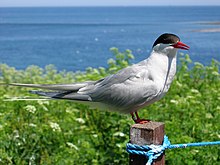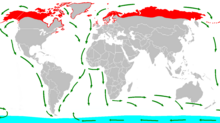
Back Arktiese sterretjie Afrikaans خرشنة قطبية Arabic خرشنه قطبيه ARZ Sterna paradisaea AST Qütb susüpürəni Azerbaijani Крачка палярная Byelorussian Полярна рибарка Bulgarian স্টারনা প্যারাডাইসাইয়া Bengali/Bangla བྱང་སྣེའི་སྐྱར་རྟ། Tibetan Skravig an Hanternoz Breton
| Arctic tern | |
|---|---|

| |
| Farne Islands | |
| Scientific classification | |
| Domain: | Eukaryota |
| Kingdom: | Animalia |
| Phylum: | Chordata |
| Class: | Aves |
| Order: | Charadriiformes |
| Family: | Laridae |
| Genus: | Sterna |
| Species: | S. paradisaea
|
| Binomial name | |
| Sterna paradisaea Pontoppidan, 1763[2]
| |

| |
| Range of S. paradisaea Breeding grounds wintering grounds migration routes | |
| Synonyms | |
|
Sterna portlandica | |
The Arctic tern (Sterna paradisaea) is a tern in the family Laridae. This bird has a circumpolar breeding distribution covering the Arctic and sub-Arctic regions of Europe (as far south as Brittany), Asia, and North America (as far south as Massachusetts). The species is strongly migratory, seeing two summers each year as it migrates along a convoluted route from its northern breeding grounds to the Antarctic coast for the southern summer and back again about six months later. Recent studies have shown average annual round-trip lengths of about 70,900 km (44,100 mi) for birds nesting in Iceland and Greenland and about 48,700 km (30,300 mi) for birds nesting in the Netherlands. These are by far the longest migrations known in the animal kingdom. The Arctic tern nests once every one to three years (depending on its mating cycle).
Arctic terns are medium-sized birds. They have a length of 28–39 cm (11–15 in) and a wingspan of 65–75 cm (26–30 in).[3] They are mainly grey and white plumaged, with a red/orange beak and feet, white forehead, a black nape and crown (streaked white), and white cheeks. The grey mantle is 305 mm (12.0 in), and the scapulae are fringed brown, some tipped white. The upper wing is grey with a white leading edge, and the collar is completely white, as is the rump. The deeply forked tail is whitish, with grey outer webs.
Arctic terns are long-lived birds, with many reaching fifteen to thirty years of age. They eat mainly fish and small marine invertebrates. The species is abundant, with an estimated two million individuals. While the trend in the number of individuals in the species as a whole is not known, exploitation in the past has reduced this bird's numbers in the southern reaches of its ranges.
- ^ BirdLife International (2018). "Sterna paradisaea". IUCN Red List of Threatened Species. 2018: e.T22694629A132065195. doi:10.2305/IUCN.UK.2018-2.RLTS.T22694629A132065195.en. Retrieved 12 November 2021.
- ^ Cite error: The named reference
Birdlife Internationalwas invoked but never defined (see the help page). - ^ Cite error: The named reference
AABwas invoked but never defined (see the help page).
